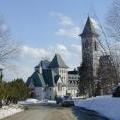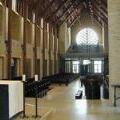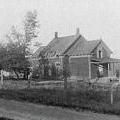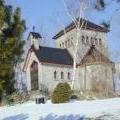 "In a civilization more and more mobile, loud-sounding and speaking, zones of silence become a vital necessity. So monasteries more than ever are called to be haunts of peace and interiority. Never let internal or external pressures affect your traditions and your means of recollection. Rather do what you can to educate your guests and retreatants to observe the virtue of silence. Cherish your separation from the world so comparable to the biblical desert. Paradoxically, this desert is not emptiness; that is where the Lord speaks to your heart and associates you closely to his work of salvation.
"In a civilization more and more mobile, loud-sounding and speaking, zones of silence become a vital necessity. So monasteries more than ever are called to be haunts of peace and interiority. Never let internal or external pressures affect your traditions and your means of recollection. Rather do what you can to educate your guests and retreatants to observe the virtue of silence. Cherish your separation from the world so comparable to the biblical desert. Paradoxically, this desert is not emptiness; that is where the Lord speaks to your heart and associates you closely to his work of salvation.
--Pope John-Paul II, 1980
An imposing structure overlooks the western shore of Lake Memphremagog near the village of Austin. It is the Benedictine monastery, St-Benoît-du-Lac. Viewed from across the lake, St-Benoît calls to mind a French chateau. With its turrets, green copper roofs, and walls of stone, it sits in striking contrast to the green hillside that slopes gently down to the water. Mount Owl's Head looms majestically in the distance. Surely the monks could not have chosen a more stunning setting!
PERSEVERENCE
The history of St-Benoît-du-Lac is one of perseverance. The monastery dates back to 1912 when a handful of exiled French monks arrived in Canada from Belgium. Their leader, Dom Paul Vannier, had found an ideal spot in the Eastern Townships. With the blessing of the Bishop of Sherbrooke, he purchased an old farm on the shore of Lake Memphremagog. Ironically, the spot he chose was on the very site chosen by the Quaker pioneer of Bolton Township, Nicholas Austin, 120 years before. Great men think alike.
 For the first years of its existence, the tiny monastic community struggled. Poverty, isolation, and hard work took their toll. Making things even worse, Dom Vannier drowned in a boating accident on the lake. At one point, the monastery (then a mere "cella" occupying a simple farmhouse) was nearly closed. When two Canadian monks went to Europe to plead for support, the group was granted a reprieve.
For the first years of its existence, the tiny monastic community struggled. Poverty, isolation, and hard work took their toll. Making things even worse, Dom Vannier drowned in a boating accident on the lake. At one point, the monastery (then a mere "cella" occupying a simple farmhouse) was nearly closed. When two Canadian monks went to Europe to plead for support, the group was granted a reprieve.
In the years that followed, the situation improved and the community began to grow. In 1935, St-Benoît was granted the status of an autonomous monastery. St-Benoît was by then a sprawling three-storey wooden building, but in 1938 the monks decided to construct a more substantial, more ambitious monastery. They enlisted the help of a French Benedictine architect, Dom Paul Bellot. The new buildings were inaugurated in 1941. In 1952, St-Benoît became an abbey, and since then several additions have been made, including a hostel for visitors and in 1994 a splendid new church.
 TRANQUILITY
TRANQUILITY
Today, St-Benoit-du-Lac is famous not only for its spectacular architecture and surroundings, but for being a place of respite for pilgrims from around the world. Visitors can either come for the day, or (if they have a reservation) stay over night at one of the abbey's two hostels, which accommodate up to 50 men and 15 women. Reflection, prayer, and tranquility are the rule.
TOURISM
St-Benoît is a major tourist site, attracting between 100 and 200,000 visitors per year, according to Dom Jacques Bolduc. Dom Bolduc, whose official title is "cellarer", is responsible for all things administrative. He says that the abbey is an enormous benefit to the region's tourism industry. He estimates that between 1000 and 2000 people visit each week in the peak summer months. Some of these people stay at the hostels, he says, but many come just for the masses that are celebrated daily at 11 a.m. with Gregorian chants in the abbey church, which seats 500 and which is usually full on Sundays. Other visitors come to sample the famous St-Benoît cheese, which the monks produce on the premises. Others come for the apple cider, produced from apples grown in the Abbey's orchards. A boutique boasts a selection of produce as well as musical recordings, books, and religious articles.
 Miraculously the Abbey is able to maintain its primary vocation of meditation and prayer, while at the same time welcoming large numbers of people. This is due in part to the fact that while certain areas are open to the public, others are strictly off-limits. The population of St-Benoît-du-Lac varies between fifty and sixty, depending on the number of novices in residence at any given time. Monks divide their time between religious and agricultural duties, explains Dom Bolduc.
Miraculously the Abbey is able to maintain its primary vocation of meditation and prayer, while at the same time welcoming large numbers of people. This is due in part to the fact that while certain areas are open to the public, others are strictly off-limits. The population of St-Benoît-du-Lac varies between fifty and sixty, depending on the number of novices in residence at any given time. Monks divide their time between religious and agricultural duties, explains Dom Bolduc.
MUNICIPAL CURIOSITY
St-Benoît is something of curiosity. The Abbey, along with its 225 hectares (560 acres) of land, is actually a municipality unto itself, a kind of Vatican City in miniature. "Yes, you could say that," laughs one official at the Quebec Federation of Municipalities. "It's certainly the only one in the province we know of."
 Carved out of the municipality of Austin in 1939, St-Benoît was created in part because Austin, itself carved out of Bolton East the year before, was worried about having to provide the monks with the usual services (water, electricity and so on), while the monks would legally be required to pay no municipal taxes. The people of Austin and the monks agreed that it would be in everyone's interest for the monastery to form its own town. Dom Bolduc says that this sort of thing was rare in Quebec at that time, but not unheard of. There were, he says, other institutions that were municipalities. One example was a hospital in Quebec City.
Carved out of the municipality of Austin in 1939, St-Benoît was created in part because Austin, itself carved out of Bolton East the year before, was worried about having to provide the monks with the usual services (water, electricity and so on), while the monks would legally be required to pay no municipal taxes. The people of Austin and the monks agreed that it would be in everyone's interest for the monastery to form its own town. Dom Bolduc says that this sort of thing was rare in Quebec at that time, but not unheard of. There were, he says, other institutions that were municipalities. One example was a hospital in Quebec City.
Today St-Benoît still maintains its independence. Dom Bolduc, in the role of pro-mayor, attends regular meetings of the Memphremagog MRC (regional county). St-Benoît, however, forgoes the traditional municipal organization and is administered by a corporation composed of Benedictine monks.
 Asked if the monks are worried about the government's forced municipal mergers, Dom Bolduc explains that since its creation, the little enclave has rarely if ever asked the province for anything. "In 1958, we were the first ones in the area to build a water treatment plant. We had to because, with our cheese making, we didn't want to cause any pollution. We didn't ask for a cent, and paid for it all ourselves." He adds, chuckling, "No, we're not worried. We ask for nothing, so they leave us alone."
Asked if the monks are worried about the government's forced municipal mergers, Dom Bolduc explains that since its creation, the little enclave has rarely if ever asked the province for anything. "In 1958, we were the first ones in the area to build a water treatment plant. We had to because, with our cheese making, we didn't want to cause any pollution. We didn't ask for a cent, and paid for it all ourselves." He adds, chuckling, "No, we're not worried. We ask for nothing, so they leave us alone."
For more information, the abbey website is at: http://www.st-benoit-du-lac.com.